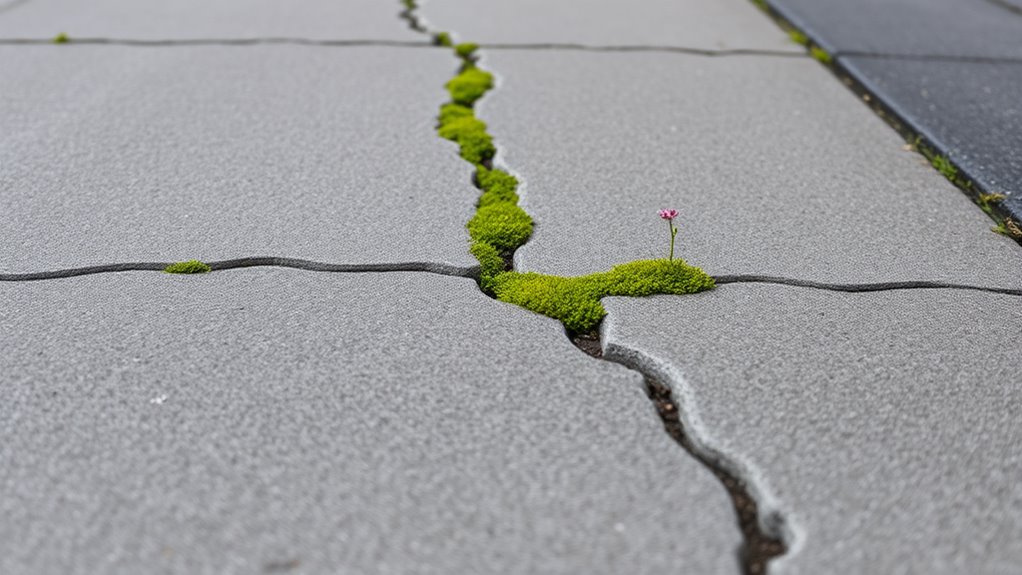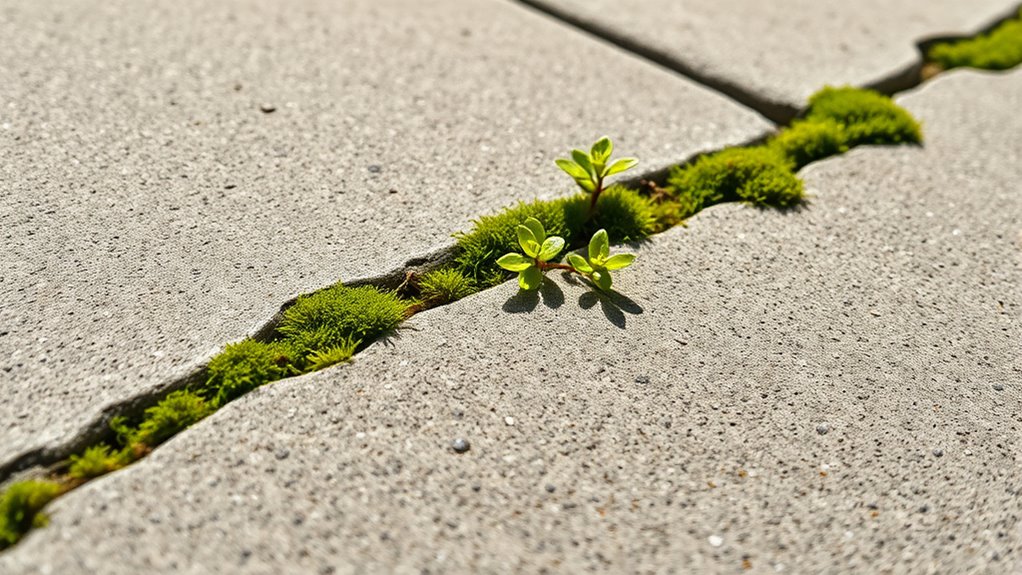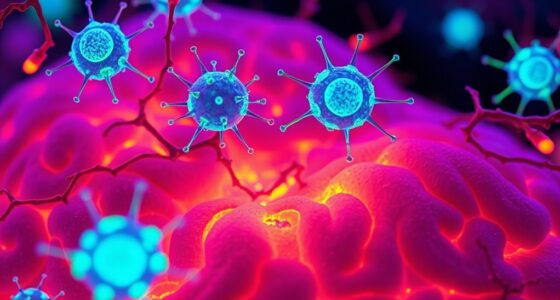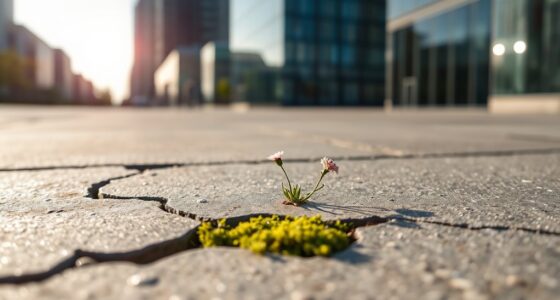Bio-inspired concrete that heals its own cracks uses biological processes like bacteria or encapsulated agents to repair damage automatically. This innovation helps extend the life of urban structures, reduce maintenance costs, and minimize environmental impact. Imagine fewer potholes, longer-lasting bridges, and safer roads—benefiting cities and residents alike. By adopting these smart materials, cities can become more resilient and sustainable. If you want to discover how this technology is transforming urban spaces, keep exploring further.
Key Takeaways
- Bio-inspired concrete uses self-healing mechanisms like bacteria or encapsulated agents to automatically repair cracks.
- This technology extends infrastructure lifespan, reducing maintenance costs and resource consumption in urban development.
- It minimizes disruptions by decreasing the frequency of repairs and road closures, improving city life quality.
- Self-healing concrete enhances safety and durability of structures such as bridges and buildings.
- Adoption of these materials promotes sustainable, eco-friendly cities by supporting resilient and long-lasting urban infrastructure.

Imagine a future where concrete can repair its own cracks without human intervention. This isn’t just a sci-fi dream; it’s becoming a reality thanks to innovations inspired by nature. Bio-inspired concrete incorporates self-healing materials that mimic biological processes, allowing structures to mend themselves automatically.
This technology promises a new era for sustainable construction, reducing maintenance costs and extending the lifespan of infrastructure. Instead of constantly patching up damaged roads, bridges, or buildings, you’ll see these structures actively repairing their own flaws, minimizing disruptions and conserving resources.
Self-healing materials in concrete utilize various mechanisms, such as encapsulated healing agents or bacteria that produce limestone when cracks form. When a crack appears, these agents activate, sealing the fissure and preventing further deterioration.
This process not only preserves the integrity of the structure but also drastically cuts down on the need for frequent repairs. In the context of sustainable construction, this approach aligns perfectly with environmental goals. It reduces the necessity for new materials and energy-intensive maintenance, helping cities lower their carbon footprint and make better use of existing infrastructure.
You might wonder how this impacts urban living. Well, imagine fewer road closures due to potholes, longer-lasting bridges, and buildings that stay sturdy for decades without constant upkeep.
As concrete becomes smarter and more resilient, cities can invest less in ongoing repairs and more in developing resilient urban environments. This shift contributes to sustainability by decreasing waste and conserving natural resources, all while maintaining safety and functionality.
Plus, with less frequent repairs, you’ll notice fewer disruptions in daily life, making urban spaces more reliable and less costly over time.
The integration of self-healing materials into construction practices also encourages innovation. Engineers and architects can design structures with longer lifespans, reducing the need for replacement and demolition.
Over time, this leads to more sustainable cities, where infrastructure is both environmentally friendly and economically efficient. As these bio-inspired solutions become mainstream, you’ll see a transformation in how cities grow and maintain themselves.
This technology not only saves money but also aligns with global efforts to create environmentally responsible urban spaces.
In essence, bio-inspired concrete that heals itself offers a compelling vision of sustainable construction. By harnessing self-healing materials, you get durable, eco-friendly infrastructure that requires less maintenance and lasts longer.
This innovation not only benefits city budgets but also supports environmental conservation, making urban living safer, more sustainable, and more efficient for generations to come.
Frequently Asked Questions
How Long Does Self-Healing Concrete Typically Last?
You’re wondering how long self-healing concrete lasts. Typically, its durability lifespan exceeds traditional concrete, often reaching 50 years or more with proper maintenance.
The material’s longevity depends on factors like environment and usage, but its self-healing properties help extend its lifespan by automatically repairing cracks.
This means you can expect increased durability and a longer-lasting structure, reducing repair costs and improving overall resilience over time.
What Environmental Impacts Does Bio-Inspired Concrete Have?
Think of bio-inspired concrete as a green guardian for your city’s infrastructure. Its environmental impacts are generally positive, reducing the carbon footprint compared to traditional materials by lowering energy use during production.
Plus, it promotes resource sustainability through self-healing abilities, extending lifespan and decreasing the need for repairs. This eco-friendly approach helps cities build resilient, sustainable environments while minimizing harm to the planet’s delicate balance.
Can This Concrete Be Used in Extreme Weather Conditions?
You can definitely use this concrete in extreme weather conditions. Its temperature resilience helps it withstand both scorching heat and freezing cold.
Its freeze-thaw durability guarantees it doesn’t crack or deteriorate during repeated freeze and thaw cycles. This makes it ideal for regions with harsh climates, giving you confidence that your structures will stay durable and intact, even under severe temperature fluctuations.
Is Bio-Inspired Concrete Cost-Effective Compared to Traditional Options?
Think of choosing concrete like weighing a treasure chest against a piggy bank. Bio-inspired concrete might seem costly upfront, but a thorough cost analysis shows it could save money long-term through reduced maintenance and repairs.
Material expenses are higher initially, but its self-healing ability minimizes cracks and damage, lowering overall costs. So, you could see it as a smart investment that pays off over time, making it more cost-effective than traditional options.
How Scalable Is the Production of Bio-Inspired Self-Healing Concrete?
You wonder how scalable bio-inspired self-healing concrete production is. While promising, manufacturing challenges like maintaining quality control and integrating living components pose hurdles.
The supply chain must adapt to source specialized materials consistently. Although advances are making large-scale production more feasible, current limitations mean it’s not yet fully scalable for widespread construction.
Continued research and development will be key to overcoming these challenges and expanding its availability.
Conclusion
Just like the legendary phoenix rises from its ashes, this bio-inspired concrete offers a new dawn for our cities. Imagine roads and buildings that heal themselves, reducing repairs and extending lifespan—transforming urban life. By embracing nature’s wisdom, we’re stepping into a future where our infrastructure becomes resilient and sustainable. This innovation isn’t just a breakthrough; it’s a call to action, reminding you that with nature’s guidance, we can build smarter, stronger, and more enduring cities.










